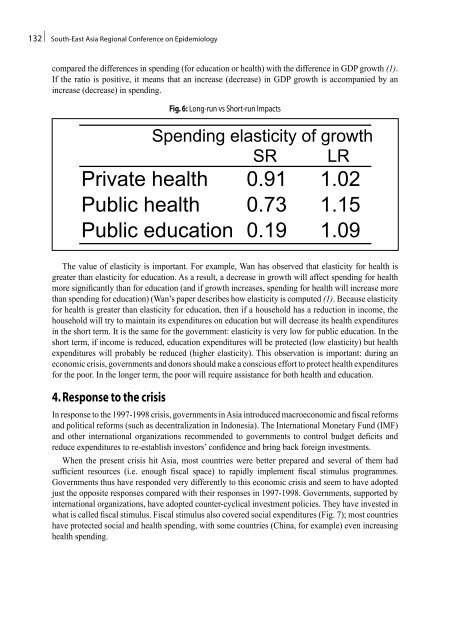South-East Asia Regional Conference on Epidemiology
South-East Asia Regional Conference on Epidemiology
South-East Asia Regional Conference on Epidemiology
You also want an ePaper? Increase the reach of your titles
YUMPU automatically turns print PDFs into web optimized ePapers that Google loves.
132 | <str<strong>on</strong>g>South</str<strong>on</strong>g>-<str<strong>on</strong>g>East</str<strong>on</strong>g> <str<strong>on</strong>g>Asia</str<strong>on</strong>g> <str<strong>on</strong>g>Regi<strong>on</strong>al</str<strong>on</strong>g> <str<strong>on</strong>g>C<strong>on</strong>ference</str<strong>on</strong>g> <strong>on</strong> <strong>Epidemiology</strong><br />
compared the differences in spending (for educati<strong>on</strong> or health) with the difference in GDP growth (1).<br />
If the ratio is positive, it means that an increase (decrease) in GDP growth is accompanied by an<br />
increase (decrease) in spending.<br />
Fig. 6: L<strong>on</strong>g-run vs Short-run Impacts<br />
Spending elasticity of growth<br />
SR LR<br />
Private health 0.91 1.02<br />
Public health 0.73 1.15<br />
Public educati<strong>on</strong> 0.19 1.09<br />
The value of elasticity is important. For example, Wan has observed that elasticity for health is<br />
greater than elasticity for educati<strong>on</strong>. As a result, a decrease in growth will affect spending for health<br />
more significantly than for educati<strong>on</strong> (and if growth increases, spending for health will increase more<br />
than spending for educati<strong>on</strong>) (Wan’s paper describes how elasticity is computed (1). Because elasticity<br />
for health is greater than elasticity for educati<strong>on</strong>, then if a household has a reducti<strong>on</strong> in income, the<br />
household will try to maintain its expenditures <strong>on</strong> educati<strong>on</strong> but will decrease its health expenditures<br />
in the short term. It is the same for the government: elasticity is very low for public educati<strong>on</strong>. In the<br />
short term, if income is reduced, educati<strong>on</strong> expenditures will be protected (low elasticity) but health<br />
expenditures will probably be reduced (higher elasticity). This observati<strong>on</strong> is important: during an<br />
ec<strong>on</strong>omic crisis, governments and d<strong>on</strong>ors should make a c<strong>on</strong>scious effort to protect health expenditures<br />
for the poor. In the l<strong>on</strong>ger term, the poor will require assistance for both health and educati<strong>on</strong>.<br />
4. Resp<strong>on</strong>se to the crisis<br />
In resp<strong>on</strong>se to the 1997-1998 crisis, governments in <str<strong>on</strong>g>Asia</str<strong>on</strong>g> introduced macroec<strong>on</strong>omic and fiscal reforms<br />
and political reforms (such as decentralizati<strong>on</strong> in Ind<strong>on</strong>esia). The Internati<strong>on</strong>al M<strong>on</strong>etary Fund (IMF)<br />
and other internati<strong>on</strong>al organizati<strong>on</strong>s recommended to governments to c<strong>on</strong>trol budget deficits and<br />
reduce expenditures to re-establish investors’ c<strong>on</strong>fidence and bring back foreign investments.<br />
When the present crisis hit <str<strong>on</strong>g>Asia</str<strong>on</strong>g>, most countries were better prepared and several of them had<br />
sufficient resources (i.e. enough fiscal space) to rapidly implement fiscal stimulus programmes.<br />
Governments thus have resp<strong>on</strong>ded very differently to this ec<strong>on</strong>omic crisis and seem to have adopted<br />
just the opposite resp<strong>on</strong>ses compared with their resp<strong>on</strong>ses in 1997-1998. Governments, supported by<br />
internati<strong>on</strong>al organizati<strong>on</strong>s, have adopted counter-cyclical investment policies. They have invested in<br />
what is called fiscal stimulus. Fiscal stimulus also covered social expenditures (Fig. 7); most countries<br />
have protected social and health spending, with some countries (China, for example) even increasing<br />
health spending.









